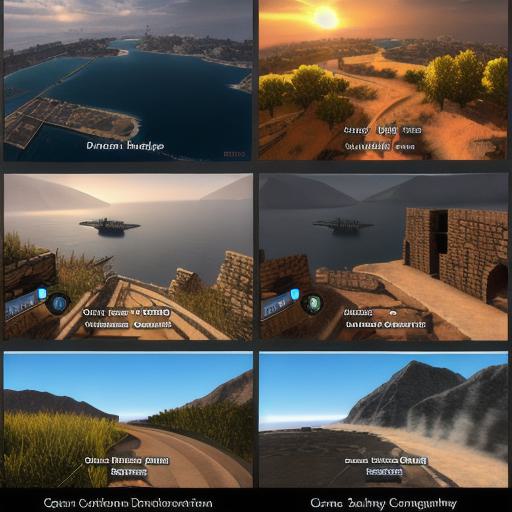As video games continue to grow in popularity, so does the demand for skilled game developers. But where do these talented individuals typically work in the gaming industry? In this article, we’ll take a closer look at the different types of companies and roles that game developers can find in the gaming world.
Independent Game Developers
Many game developers choose to work independently, creating games on their own or with a small team of collaborators. These independent game developers often work from home or a co-working space, giving them more control over their projects and allowing them to focus on the creative aspects of game development. Some popular platforms for independent game developers include Itch.io, Steam Greenlight, and GOG Galaxy.
Large Game Development Studios
Another option for game developers is to work for a large gaming studio. These companies typically employ hundreds or even thousands of developers, designers, and other staff members, all working together to create blockbuster video games. Some examples of large game development studios include Epic Games (Fortnite), Ubisoft (Assassin’s Creed), and Rockstar Games (Red Dead Redemption 2).
Publishers and Distributors
In addition to game developers, there are also a number of companies that focus on publishing and distributing video games. These companies often have a wide range of roles, from marketing and sales to product management and quality assurance. Examples of publishers and distributors in the gaming industry include Activision Blizzard (Call of Duty), Electronic Arts (Madden NFL), and Sony Interactive Entertainment (God of War).

Educational Institutions
Finally, some game developers choose to work at educational institutions like universities and colleges. These individuals often teach game design and development courses, as well as conduct research on the latest trends and technologies in the gaming industry. Some examples of educational institutions that hire game developers include Carnegie Mellon University (Game Design program), University of California, Irvine (School of Computer Science – Game Design), and Rhode Island School of Design (Animation + Digital Media).
The Benefits of Working in the Gaming Industry
Now that we’ve taken a closer look at the different types of companies and roles that game developers can find in the gaming industry, let’s explore some of the benefits of working in this exciting field.
High Demand for Skilled Workers
As video games continue to grow in popularity, there is always a high demand for skilled workers like game developers. This means that game developers have a wide range of job opportunities to choose from and are often able to find work in their preferred location and industry.
Opportunities for Creativity
Game development is a highly creative field that allows developers to express themselves through code, art, and design. With the ability to create new worlds, characters, and stories, game developers have the opportunity to use their imagination and creativity in ways that few other professions can.
Continuous Learning and Improvement
The gaming industry is constantly evolving, with new technologies and trends emerging all the time. This means that game developers have the opportunity to continuously learn and improve their skills, keeping up with the latest developments in the field.
Opportunities for Collaboration
Finally, game development often requires collaboration between different teams of developers, designers, artists, and other staff members. This can be a highly rewarding experience, as it allows game developers to work together to create something truly special.
Real-Life Examples of Game Developers in Action
Now that we’ve explored the benefits of working in the gaming industry, let’s take a closer look at some real-life examples of game developers in action.
Case Study: John Carmack
John Carmack is a legendary game developer who co-founded id Software, the company behind the Doom and Quake video game franchises. A pioneer in the field of 3D graphics, Carmack was known for his innovative use of technology to create stunning visual effects and immersive gameplay experiences. His work helped pave the way for a new generation of video games and cemented his place as one of the most influential figures in the gaming industry.
Case Study: Maeve Dove
Maeve Dove is a game developer who has worked on a wide range of projects, from mobile games to virtual reality experiences. She is also an advocate for diversity and inclusion in the gaming industry, working to promote greater representation and equality for underrepresented groups. One of her most notable projects was "Bubblegum Island," a free-to-play game that used augmented reality technology to bring players together in real-life experiences.
Case Study: Shigeru Miyamoto
Shigeru Miyamoto is a Japanese game designer who is best known as the creator of the Mario video game franchise. A true visionary in the gaming world, Miyamoto has always been focused on creating fun and engaging gameplay experiences that delight players of all ages. His work has inspired generations of game developers and cemented his place as one of the most influential figures in the gaming industry.
Comparing and Contrasting Different Types of Game Development Roles
Now that we’ve looked at some real-life examples of game developers in action, let’s take a closer look at the different types of game development roles and how they compare and contrast.
Independent Game Developers
vs.
Large Game Development Studios
One of the biggest differences between independent game developers and large game development studios is the level of control that developers have over their projects. Independent game developers typically have more autonomy, as they are often working on smaller projects with fewer resources. This can be both a strength and a weakness, as it allows them to focus on their creative vision but may also limit their ability to scale up or take on more complex projects. Large game development studios, on the other hand, typically have more resources at their disposal, allowing them to take on larger and more ambitious projects. However, this can also lead to a more bureaucratic and structured work environment.
Publishers and Distributors
vs.
Educational Institutions
Another key difference between publishers and distributors and educational institutions is the focus of their activities. Publishers and distributors are primarily focused on marketing, selling, and distributing video games to consumers. This can involve a wide range of roles, from product management and sales to marketing and advertising. Educational institutions, on the other hand, are focused on teaching and research related to game design and development. While there may be some overlap between these two groups, the primary focus of each is different.
Case Studies: John Carmack vs. Maeve Dove vs. Shigeru Miyamoto

Now that we’ve compared and contrasted different types of game development roles, let’s take a closer look at some of the key skills and attributes required for each type of role, using examples from John Carmack, Maeve Dove, and Shigeru Miyamoto.
John Carmack: Technical Expertise and Innovation
John Carmack is known for his technical expertise and innovative use of technology to create stunning visual effects and immersive gameplay experiences. He was a pioneer in the field of 3D graphics, using his technical skills to push the boundaries of what was possible with early computer hardware. His ability to think creatively and outside the box has been instrumental in his success as a game developer, as he has always been focused on creating something truly unique and groundbreaking.
Maeve Dove: Collaboration and Communication Skills
Maeve Dove is an advocate for diversity and inclusion in the gaming industry, working to promote greater representation and equality for underrepresented groups. She is also known for her ability to collaborate effectively with other team members, working together to create compelling gameplay experiences that delight players. Her strong communication skills have been instrumental in her success as a game developer, as she has always been focused on building strong relationships with her colleagues and stakeholders.
Shigeru Miyamoto: Creativity and Vision
Shigeru Miyamoto is known for his creativity and vision as a game designer. He has always been focused on creating fun and engaging gameplay experiences that delight players of all ages. His ability to think creatively and outside the box has been instrumental in his success as a game developer, as he has always been focused on pushing the boundaries of what is possible with video games.
Summary: The Importance of Game Development Roles in the Gaming Industry
In conclusion, game development roles are an essential part of the gaming industry, providing a range of different skills and perspectives that are necessary to create compelling gameplay experiences. From technical expertise and innovation to collaboration and communication skills, each type of role is crucial to the success of the industry as a whole. By understanding the key skills and attributes required for each type of role, we can better appreciate the diverse array of talents and abilities that make up the world of game development.



